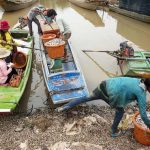One in nine has no access to clean water

Every year during the wet season, millions of Cambodians are surrounded by water as the Mekong River floods. Yet the water is unsafe to drink, fouled by sewage and agricultural and industrial pollution. Living in villages on stilts, Cambodians bathe, fish and defecate in the flooded Tonle Sap, South-east Asia’s largest freshwater lake. Storage of clean water is difficult and traditional forms of sanitation, such as pit toilets, are not possible. This leaves children especially vulnerable to water-borne diseases. According to Unicef, about 6.3 million Cambodians, or about 40 per cent of the population, lack access to safe water. Their plight mirrors a broader global crisis in which one in nine people does not have access to clean water and one in three lacks improved sanitation. Many live in the developing economies of Asia and sub-Saharan Africa. While governments and non-governmental organisations have worked hard to bring clean water to millions of people, demand for water is spiralling. Rapid population growth is fuelling more demand for food and goods, meaning agriculture and industry are using ever greater amounts of water.

